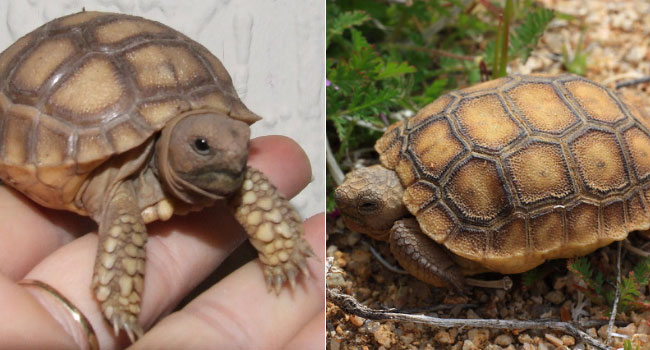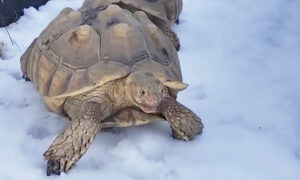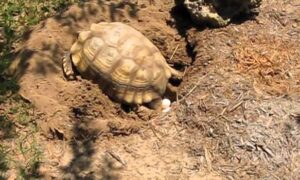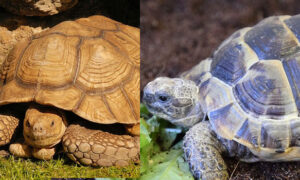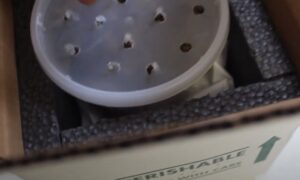Although adult and larger individuals are easy to differentiate, it can be hard to identify baby and juvenile sulcatas and desert tortoises. They’re both tan and have similar physical traits, however there are a few indicators to visually differentiate sulcata vs desert tortoises.
Desert Tortoise VS Sulcata Appearance
Size: Adult sulcata tortoises are much larger, averaging 80-100 lbs, whereas Desert tortoises weigh between 8-15 lbs. Sulcata tortoises measure up to 30 inches long, where adult Desert tortoises measure between 9-15 inches.
Spurs: Sulcata tortoises have large spurs (pointed scales) on the front legs, where Desert tortoises have small scales on their legs.
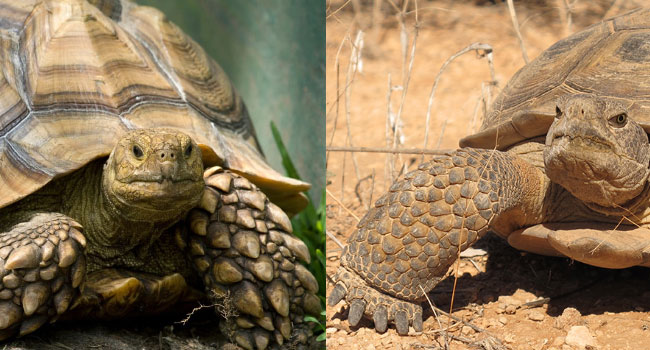
Nuchal Scute: Desert tortoises have a nuchal scute that separates the marginal scutes in the center right above the head. Sulcata tortoises do not have a nuchal scute. Sulcatas have a deep V directly above the head, where the first left and right marginal scutes come together.
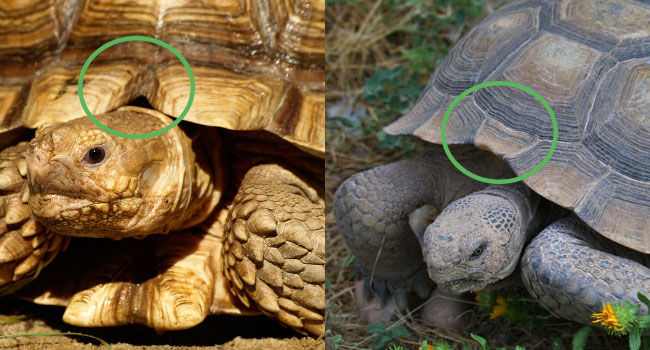
Carapace: A young sulcata tortoise has a serrated rear carapace with a wavy edge, whereas the desert tortoise has a smooth edge. Sulcatas also have a brown to yellowish-brown raised growth rings around the scutes, and desert tortoises are relatively flat.
Desert Tortoise VS Sulcata Behaviors
Hibernate: Sulcata tortoises do not hibernate, whereas Desert tortoises hibernate.
Speed: Sulcata tortoises move relatively fast for their size. Desert tortoises are slow-paced and tend to conserve their energy.
Digging: Sulcatas are known diggers and will dig large burrows in order to escape temperature and weather extremes.
Desert Tortoise VS Sulcata Diet
Sulcata tortoises maintain a diet primarily of grasses and fibrous plants; they consume a low-protein diet. Sulcatas are typically grazers, whereas desert tortoises are foragers. Desert tortoises are herbivores and consume plants, grasses and wildflowers.
Desert Tortoise VS Sulcata Habitat
Sulcata tortoises thrive in semi-arid environments with slightly humid burrows. Sulcatas are native to the Sahara Desert and the Sahel, which is a transitional zone of semi-arid grassland and savannahs. They require a large outdoor, grassy outdoor space. Desert tortoises are native to environments with rocky and sandy terrain. They are native to eastern California, southern Nevada, southwestern Utah, parts of Arizona and Mexico.
Is It Legal to have Desert Tortoises as Pets
The US Fish and Wildlife Service protects desert tortoises born after the species was placed on the Endangered Species List on August 4, 1989. It is illegal to touch or collect wild tortoises.
You can only keep captive pet desert tortoises as pets.
Sometimes, the Game and Fish Departments of Arizona, California, Nevada and Utah will adopt captive desert tortoises that cannot be released back into the wild. Consult your Fish and Wildlife Department if you are interested in adopting a desert tortoise.
If you have determined that the tortoise you found is a desert tortoise, release it back where you found it.

